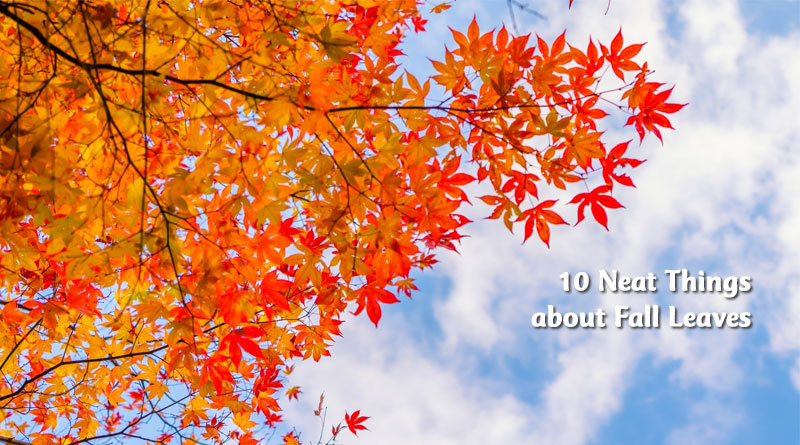10 Neat Things About Fall Leaves
1. It’s a loss not a gain of colour.
Deciduous leaves turn colour in fall because of a loss of chlorophyll, not because they pick up new hues from some mysterious place. When chlorophyll begins to break down as the days get shorter and leaf manufactories gradually close down, the green subsides, allowing the other pigments produced by carotenoids (oranges and yellows) and anthocyanins (reds and blues) to show through. Eco-Friendly Furniture
2. We don’t all fall down.
Evergreens are called evergreens for obvious reasons, even though they don’t exactly stay green all winter. Most of them become dull and dark as they, too, lose some of their chlorophyll. But evergreen needles don’t completely shut down. Instead, they are covered by a waxy coating that allows them to retain enough moisture to get through the cold season. They also produce a kind of anti-freeze to protect their cells. Still, even among evergreens, or conifers if you prefer, some leaves (needles) fall every year and the trees grow some new needles each spring. The needles of cedars and some pines last around three years. Spruce needles live about 6 years. Juniper and Douglas fir needles last for 10 or more years, while Bristlecone pine needles can persist up to 30 years. Cedars shed their old leaves in fall. Spruce trees lose theirs mostly in spring and throughout the summer. Eco-Friendly Furniture
3. Good groceries for worms.
Falling leaves are full of nutrition (read fertilizer), some more than others. Maple leaves are high on the nutrition chain, because they pump a load of good stuff into their leaves just before falling, but oaks get ready to release their leaves by sending their nutrients back to their roots. For the most part, 50% of the nutrients absorbed or created during the growing season are still there in the fallen leaf. Eco-Friendly Furniture
4. Fifty bucks a tree.
A single shade tree will shed $50 worth of plant food as humus a year. Why are you sending this valuable stuff to the local dump? In fact, weight for weight, tree leaves contain twice as many nutrients as manure. Eco-Friendly Furniture
5. What’s in a leaf?
Leaves, including the left over green stuff in the garden, contain good things such as magnesium, nitrogen, phosphorus and many trace elements. Now let’s see, my last bucket of fertilizer cost me $28.95 plus tax . . . and it contained magnesium, nitrogen, phosphorus but no trace elements. Japanese Inspired Furniture
6. Don’t waste that oak leaf.
Lest I have left you with a false impression of the hardy oak leaf by saying it sends its values south, let me clarify. While oak leaves may not contain the glories of minerals that maple leaves do, oak leaves are mighty allies in the garden. They break down slowly adding “tilth” the soil. Tilth is that lovely quality that makes soil light and easy to work with, helps retain moisture, aerates clay soils, makes sandy soil retain water and soaks up rain, not to mention, retards evaporation. Japanese Inspired Furniture
7. Dust to dust…
Leaves are part of the cycle of life. They live for a season and die, returning to earth what they borrowed from the earth in a beautiful cycle of birth and reincarnation. In this cycle, they have allies: earthworms and insects, bacteria and fungus. The worms and insects perform the first duty, breaking down the organic material to tiny pieces and thus exposing more surfaces to the next step in the deconstruction process for the fungus (moulds) and bacteria to feed and grow upon. As this happens, rainwater falls and percolates through, leaching or dissolving and carrying the left over chemicals back to the earth where it is available for the new growth in the spring time. Meanwhile, when the bacteria and fungus are finished, all that is left is a fine black dust… Sustainable Furniture
8. Temperature and weather.
Just as temperature, the season and weather govern the turning of the leaves, temperature, low nitrogen and low oxygen levels very much affect the decomposition of the leaves. Temperature affects the rate of decay. Low nitrogen inhibits the ability of the fungus and the bacteria to make proteins from the material. Oxygen is needed for the bacteria and fungus to grow. If you are a composter, you know all this, but the same principles apply to leaf decay on your lawn or in your garden. Sustainable Furniture
9. More ant farmers.
We know that ants farm aphids for their honeydew, but some tropical ants also grow fungus gardens for their sustenance. And they feed the fungus with leaf cuttings that they laboriously cut in disks to harvest and haul to their gardens. Sustainable Furniture
10. All that waste.
Forests produce one pound of dead leaves and wood per square yard every season. A forest the size of a football filed produces 3.2 tons of organics a year. This is a good thing. Leaf mould can hold anywhere from three to 500 times its weight in water. Compare that to subsoil at 20 per cent and top soil at 60%. Sustainable Furniture















